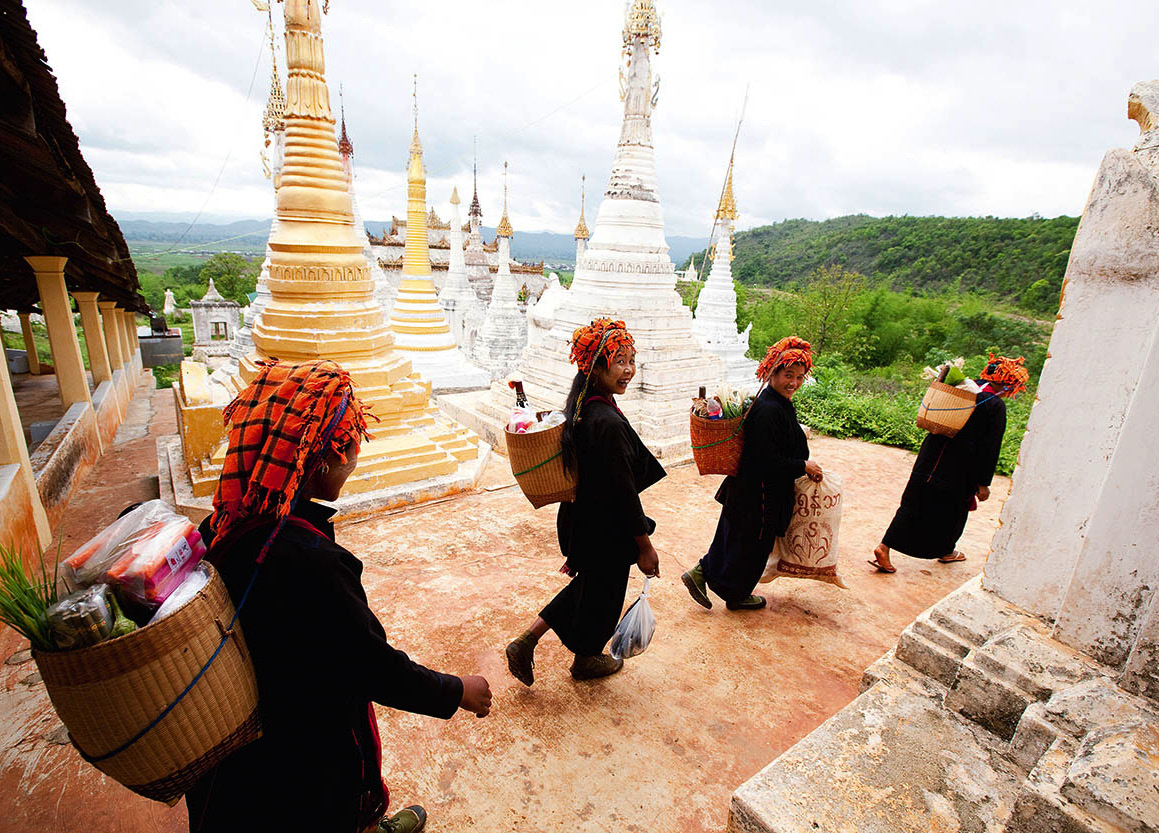By 1943, it was evident that the Japanese wanted to see Burma’s government, which they had helped establish, become subordinate to the Imperial Japanese Army. Burma was declared “independent” in August of that year, with Dr Ba Maw, former education minister, as head of the puppet state, Aung San was named minister of defence, and U Nu was chosen as foreign secretary.
The Burmese nationalists, however, were not pleased with the arrangement. In December 1944, Aung San established contact with the Allies, and in March 1945 he switched sides, with his 10,000-man army now ready to fight the Japanese. Now called the “Patriotic Burmese Forces”, they helped the Allies recapture Yangon. The Japanese surrender was signed in Burma’s capital on 28 August.

Burmese politician Aung San.
Public domain
Results of war
The war had completely devastated Burma. That which had not been destroyed during the Japanese attack was laid to waste during the Allied onslaught. There were, however, two positive results for the Burmese: their experience of nominal self-government, and the weakening of British power and prestige. It was clear Burma could no longer remain under the former colonial constitution. Yet the British, climbing back into the driver’s seat after the wartime hiatus, had other ideas, having planned a three-year period of direct rule for Burma.
Meanwhile, Aung San was quietly building up two important nationalist organisations. One of these was the Anti-Fascist People’s Freedom League, a Marxist-oriented group better known by its acronym (AFPFL). As the military wing of this political league, Aung San founded the People’s Volunteer Organisation (PVO), which, as early as 1946, claimed 100,000 (mostly unarmed) members.
Despite the growth of nationalist sentiment behind the AFPFL, the British remained firmly in control of Burma until September 1946. Then, a general strike, first by the police, then by all government employees plus railway and oil workers’ unions, brought the country to a standstill. The colonial government turned to the AFPFL and other nationalist groups for help. A moderate national council was formed, and the strike ended in early October.
The AFPFL took advantage of the weakened position of the British to seize the political initiative. Aung San presented a list of demands to the British Labour government, which included the granting of total independence to Burma by January 1948.
A conference was promptly called in London in January 1947. Burma was awarded its independence as demanded, but there were several difficult questions to resolve in negotiations, especially concerning ethnic minorities. The AFPFL representative insisted upon complete independence for all of Burma, including the minority regions; the British were concerned about the consequences of continual friction between the Bamar and other groups.
In February, however, Aung San met with minority representatives at Panglong in Shan State. The result was a unanimous resolution that all the ethnic groups would work together with the Burmese interim government to achieve independence for the minority regions in a shorter space of time. After a period of 10 years, each of the major groups that formed a state would be permitted to secede from the Union if they so desired.
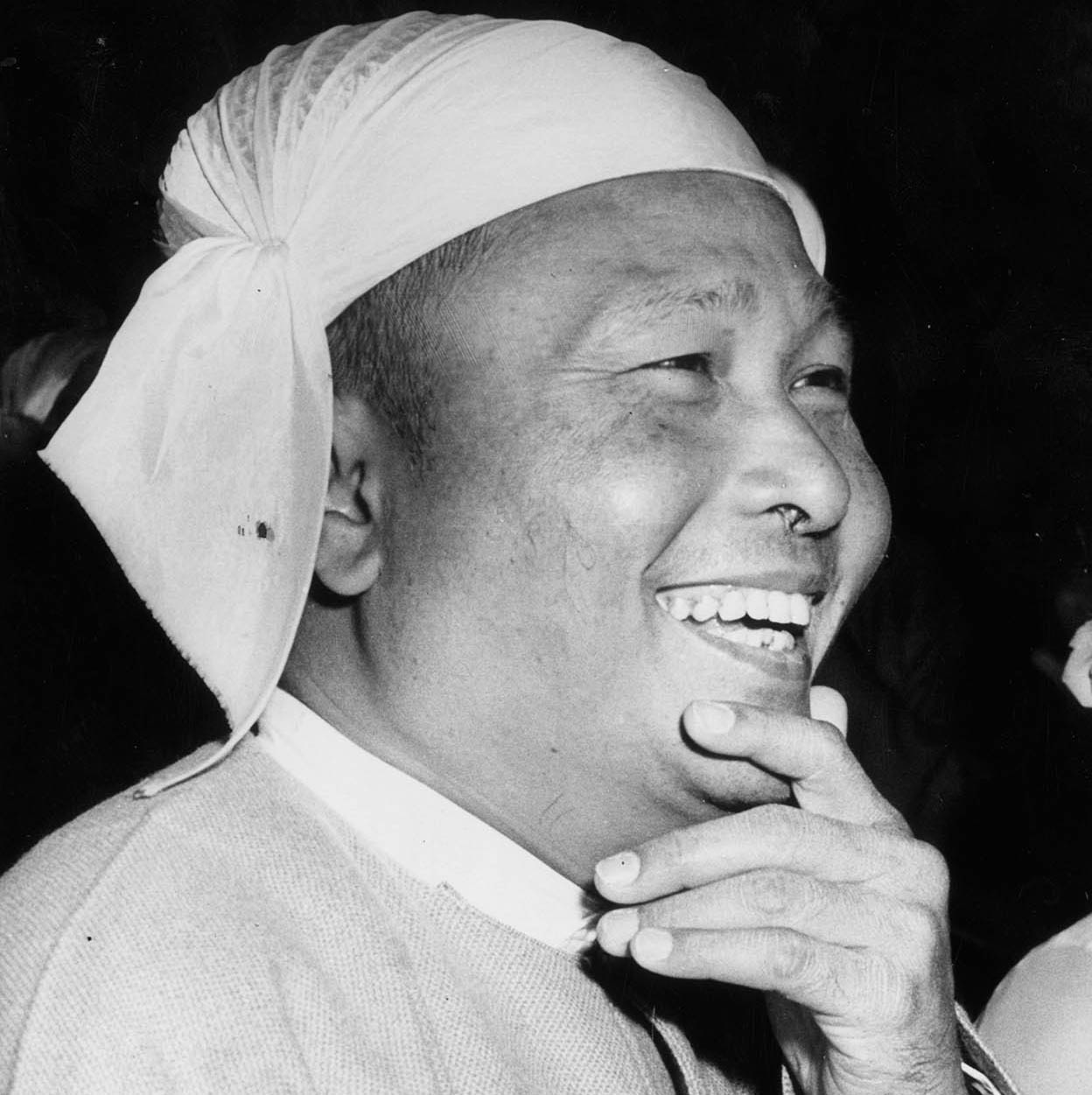
U Nu pictured in 1962 during his time under house arrest.
Getty Images
National independence
National elections for a Constituent Assembly were held in April 1947 and Aung San and his AFPFL won an overwhelming majority of seats. But on 19 July, as the new constitution was still being drafted, tragedy struck. A group of armed men burst in on a meeting of the interim government and assassinated nine people, including Aung San and six of his ministers. U Saw, right-wing prime minister of the last pre-war colonial government, was convicted of instigating the murders and executed.
The term “U” is added to the names of senior figures in Myanmar to convey honour and respect.
U Nu, one of the early leaders of the All Burma Student Movement, and later of the AFPFL, was asked by the British colonial government to step into Aung San’s shoes. U Nu became prime minister on 4 January 1948, at the astrologically auspicious hour of 4.20am, when the “Union of Burma” became an independent nation – as well as becoming the first former British colony to sever ties with the Commonwealth.
Newly independent Burma rapidly came face-to-face with the bitter realities of nationhood. The first three years of independence were marked by violent domestic confrontations and a militarisation of daily life. No less than five separate groups, including the Kayin, opposed to membership in the “Union of Burma” took up arms against the newly founded state.
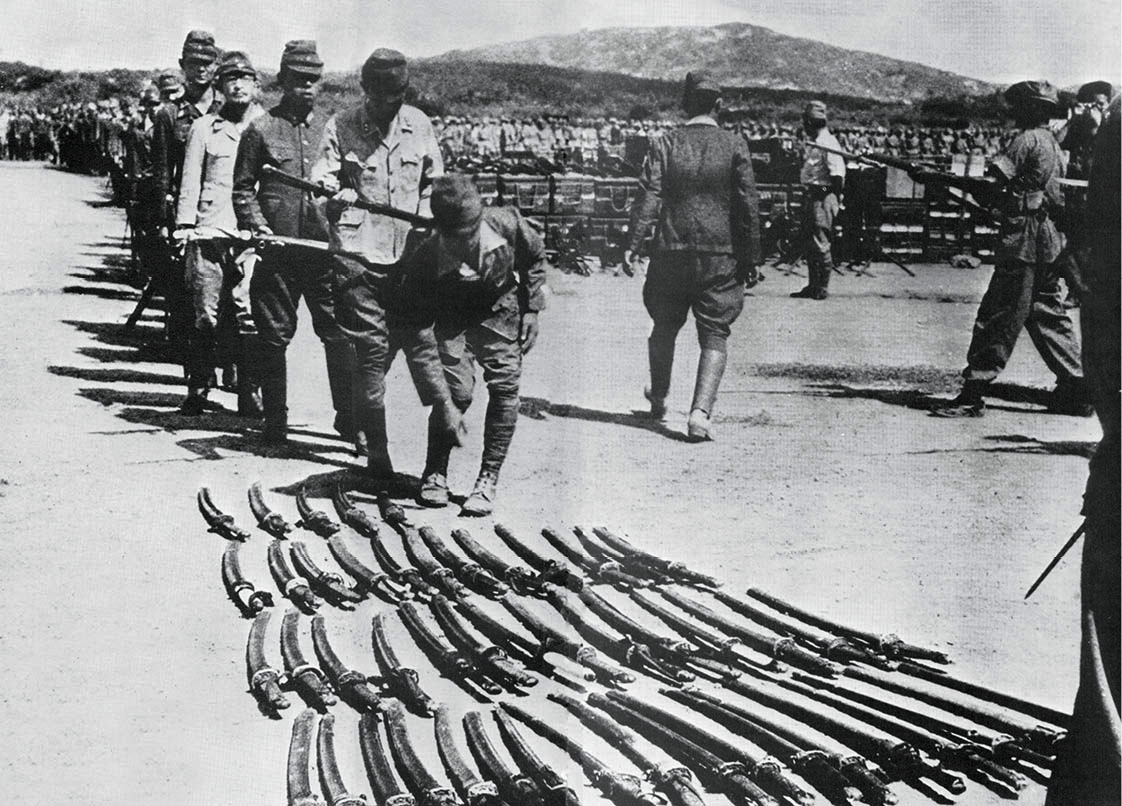
Watched by Indian soldiers, Japanese officers surrender their swords (1945).
Photoshot
One of the former Thirty Comrades, Lieutenant General Ne Win was appointed commander-in-chief of the armed forces, and soon thereafter minister of defence. The Bamar, who had not been allowed in the armed forces since the British took over in 1886, assumed all the high-ranking military posts, and all mutinous Kayin were discharged from active service.
Economic disaster
In economic terms, the first few years of independence were disastrous for Burma. Income from rice exports plummeted and tax revenue diminished, yet the expenditure that was needed to maintain the oversized military machine continued to grow.
U Nu and the AFPFL kept a firm grip on power during the 1951 national elections. But a schism within the party soon disrupted the government’s programme of economic development. The Eight-Year Plan of 1953, produced by a team of US experts and called Pyidawtha (Happy Land), had to be abandoned in 1955 due to increasing intra-party disputes.
In 1958, the squabbling had become so serious that the government was virtually paralysed. U Nu was forced to appoint a caretaker government, with General Ne Win at its helm. The 18-month administration was stern, but made progress in cleaning up the cities, modernising the archaic bureaucracy and establishing free and fair elections.
The elections were held in February 1960, and the U Nu faction of the AFPFL, renamed the Pyidaungsu (Union) Party, regained power. U Nu’s campaign promises inspired scepticism, however. He sought to have Buddhism recognised as the state religion and also promised the Mon and Rakhine people semi-autonomy. These promises spurred the Shan and Kayah to demand the right of secession granted them in the 1948 constitution, and again the U Nu government was thrown into turmoil. There was little resistance when Ne Win swept into power in a nearly bloodless coup on 2 March 1962.
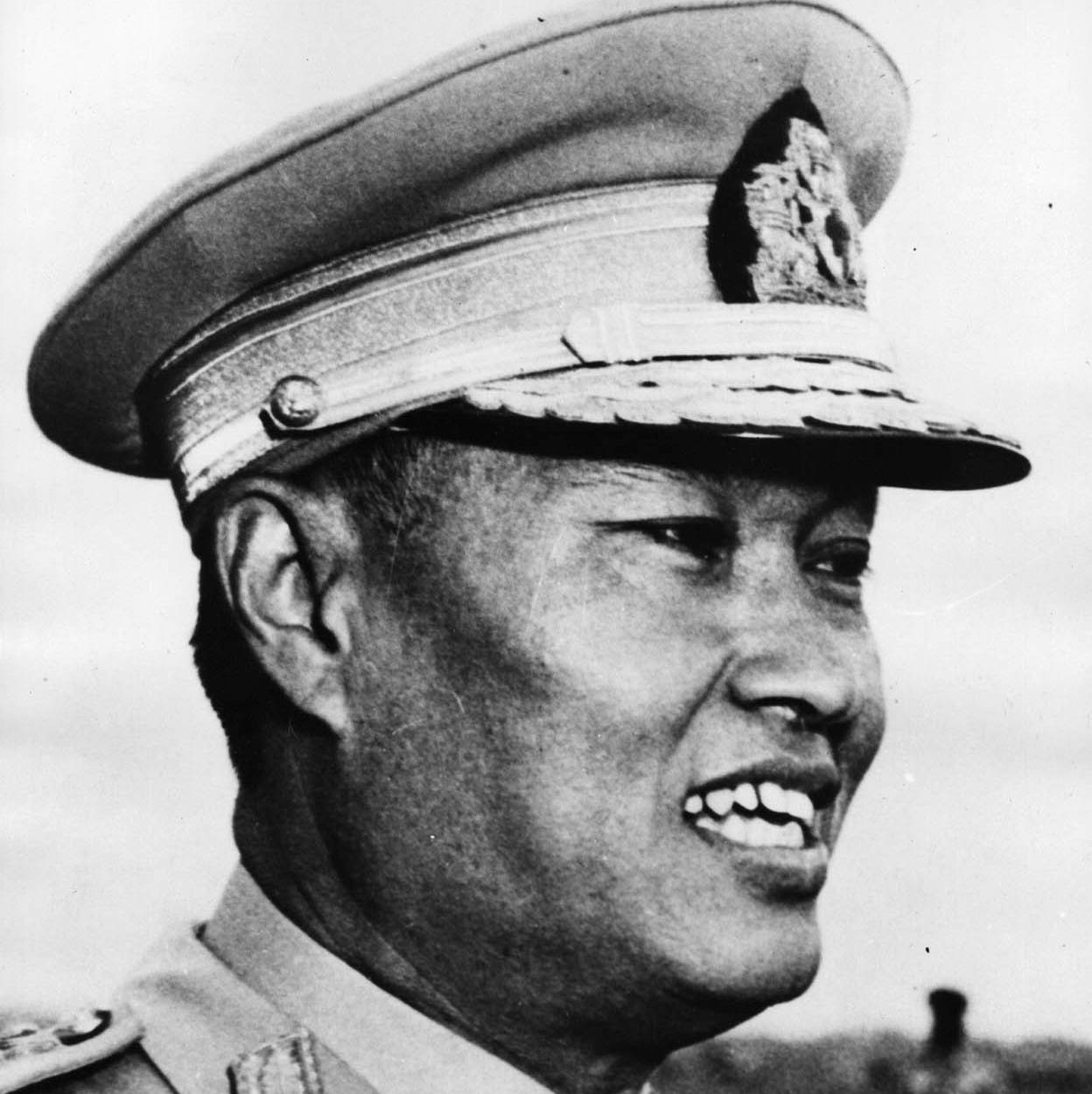
General Ne Win, thefirst military commander to be appointed prime minister of Burma.
Getty Images
The Burmese Way to Socialism
Ne Win’s first move was to appoint a Revolutionary Council made up entirely of military personnel. On 30 April, the council published its manifesto, entitled The Burmese Way to Socialism.
For 12 years, Ne Win ruled by decree, with all power vested in the Revolutionary Council. Foreign businesses were nationalised, and the state took control of all businesses, including banks. The army was put in charge of commerce and industry. A foreign policy of self-imposed isolation and neutrality was pursued.
In May 1970, former prime minister U Nu announced the formation of a National United Liberation Front (NULF), an alliance between his followers, the Mon and Kayin, as well as a smattering of Shan and Kachin. He claimed to have an army of 50,000, although that figure may well have been exaggerated. In 1971, the rebels launched successful raids from the Thai border, and, for a while, held territory inside Burma.
In Burma, meanwhile, Ne Win was reforming the government structure and introducing a constitutional authoritarianism. First, in an effort to “civilianise” the system, he dropped his military title. On 2 March 1974, the Revolutionary Council was officially disbanded and the “Socialist Republic of the Union of Burma” was born. Ne Win became president of the nation and chairman of the Burma Socialist Program Party; various leaders of the armed forces filled 16 of the 17 ministerial posts.
Ne Win stepped down from the presidency in November 1981. U San Yu, a loyal disciple, was elected to succeed him. Ne Win, then already 71, continued as Burma Socialist Program Party (BSPP) chairman, and retained behind-the-scenes power. In December 1987, the United Nations general assembly approved LDC (Least Developed Country) status for Burma, a source of much anger at embarrassment amongst the Burmese themselves.

Students protesting in Yangon, 1996, demanding democracy.
Getty Images
A year of turmoil
Frustrated by a lack of freedom and the deteriorating economy, students started to stage demonstrations in early 1988. These soon escalated, and heavy-handed government retaliation prompted the flight of thousands across the Thai border. In June 1988, a curfew was imposed in Yangon. In July, while proposing a referendum on a multi-party system, Ne Win announced his retirement as BSPP chairman.
On 8 August, a huge popular demonstration was crushed by the military, with thousands of demonstrators shot dead on the streets of Yangon. Following these huge country-wide demonstrations, the new civilian president and BSPP chairman Dr Maung Maung lifted martial law and promised a referendum and general elections under a multi-party system.
China is the Burmese regime’s principal ally, and its backing has been a major factor in allowing the generals to hold on to power for so long. How this plays out in the face of newly won Burmese freedom remains to be seen.
Meanwhile, Aung San Suu Kyi (For more information, click here), daughter of national hero Aung San, had returned unexpectedly from her home in the UK and entered the political scene, calling for a peaceful transition to democracy and the formation of an interim government.
SLORC in power
On 18 September, the Chief of Staff, General Saw Maung, announced over the radio that the military had assumed power and set up the State Law and Order Restoration Council (SLORC), with himself as prime minister. The next day the national parliament and other organs of power were dissolved. The general strike collapsed and thousands of students crossed the borders into neighbouring countries, later forming the Democratic Alliance of Burma (DAB) in which 10 ethnic resistance armies and 12 underground student groups united under the leadership of the Kayin leader Bo Mya. Opposition leaders formed the National League for Democracy (NLD), with Aung San Suu Kyi at its head.
In 1989, the English name of Burma was officially changed to that of Myanmar and the SLORC promulgated a new election law for the national parliament. Aung San Suu Kyiwas barred from participating in the elections and was placed under house arrest (she received the Nobel Peace Prize in September 1991 while still in captivity).
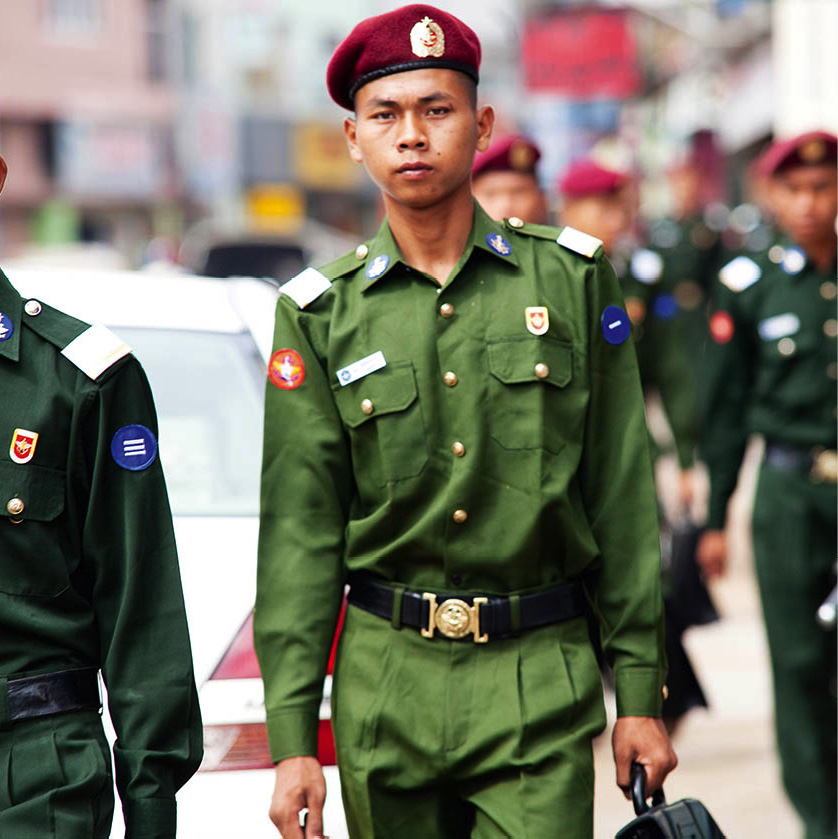
The military has a strong presence in Myanmar.
Corrie Wingate/Apa Publications
When the general elections finally took place on 27 May 1990, the NLD captured 82 percent of the vote. However, the military demanded that a new constitution should first be drafted in which different groups, including the military, should have a say. In spite of the free elections and the clear democratic vote, the military remained in control of the government. In 1993, under pressure from China, the Kachin Independence Organisation (KIO) signed a cease-fire agreement with the Yangon government, thus ending a 30-year war in the north of the country. This was soon followed by agreements with 14 other insurgent groups. Another factor was the disintegration of the BCP, once an eminent contender for power and the best-armed foe of the Burmese government’s military machine.
As if to underline these successes, and in a cosmetic bid to improve its overseas image, in 1997 the SLORC reconstituted itself as the State Peace and Development Council (SPDC).
The wait for democracy
Despite the quasi-boycott of Western nations barring Myanmar from World Bank loans and International Monetary Fund assistance, the SPDC managed to speed up the economy by attracting Southeast Asian, Chinese, Japanese and French capital, often in the form of joint ventures channelled through the regime. In the 1990s GDP grew by around 4 to 5 percent a year, but by 2003 the economy was in recession once again.
Meanwhile, the opposition became fractured and weak. Armed resistance lapsed into total disarray, with the Kayin rebels divided into mutually hostile Buddhist and Christian factions. The Thai government – long discreet supporters of the Kayin cause – were angered by the actions of “God’s Army”. This breakaway Kayin faction led by brothers Johnny and Luther Htoo (who were just ten years old when they launched the movement) seized the Burmese Embassy in Bangkok in 1999, and in 2000 hit international headlines when they took more than 400 Thai nationals hostage at a hospital in Ratchaburi.
General Ne Win
The strongman of Burmese politics for over 30 years, and a powerful force behind the SPDC, Ne Win was born at Pyay in 1910. He took the name Bo Ne Win or “Sun of Glory General” at the time of the formation of the “Thirty Comrades”. Educated at Rangoon University, he left without a degree in 1930. He worked for the post office while becoming an early member of the “Our Burma” Association. In 1943, he became commander of the Burma National Army with the rank of Japanese colonel, and in 1945 became commander of the Patriotic Burmese Forces. After the war Ne Win became second in command and later CO of the 4th Burma Rifles. He became an MP in 1947, then Commander-in-Chief of the Burmese Army in 1949. In the 1950s he served as Minister for Defence and Home Affairs, before seizing power in a military coup in 1958. In 1960 he was replaced by U Nu in general elections, but in 1962 he seized power again through a military coup. Since that time the military grip on the country has remained absolute. Ne Win resigned the presidency in 1981 and stepped down as BSPP chairman seven years later. He retained an influence over the military junta until his death in 2002.
The following year, after lengthy negotiations with the UN, NLD leader Aung San Suu Kyi was released from house arrest and permitted to travel around the country. In May 2003, her convoy was attacked by pro-government forces in the north of the country – in which 70 of her supporters were killed – resulting in another period of incarceration lasting seven years.
While the opposition considered its next move, Senior General Than Shwe embarked on one of the barmiest initiatives ever ordered by the regime: the construction of a completely new capital 320km (200 miles) north up the Sittaung Valley from Yangon. Named “Naypyidaw” (“Abode of Kings”), the city cost an estimated $4 billion to build and required the relocation of tens of thousands of government workers.
The Saffron Revolution
Before it was officially completed, however, a decision to remove fuel subsidies, which saw the price of gasoline double, led to one of the worst outbreaks of civil unrest in modern history. Initially a series of non-violent demonstrations led by students, the campaign escalated in September 2007 to a mass movement spearheaded by Buddhist monks, whence its popular name, “the Saffron Revolution”. The demonstrations were put down with characteristic brutality by the junta, which raided monasteries across the country, imprisoning at least 6,000 monks.
Disturbances rumbled on for another year but internal politics took a back seat in May 2008 after Cyclone Nargis wrought devastation across the Ayeyarwady Delta. An estimated 200,000 people were killed and billions of dollars’ worth of damage caused in the worst natural disaster ever to afflict the country. The Burmese government was criticised by international agencies for hampering the emergency aid effort.
Armed rebellions intensified in Shan State a year later, when ethnic Chinese, Wa and Kachin minorities took up arms against the Burmese army – an insurgency dubbed the Kokang Incident, in the wake of which 30,000 refugees fled across the border to China. Elsewhere in Burma, however, armed groups were fast losing ground in a series of military incursions by the army aimed at subduing the rebel forces once and for all. The crackdown bore fruit in 2010, when in exchange for assurances of representation in a future democratic government, insurgent leaders in Mon, Shan and Chin regions signed historic accords to end the violence.
The path to democracy
The move was part of a broader initiative by the military to stimulate foreign investment and a relaxation of economic sanctions against Burma. Constitutional reforms were central to the project, led by the new, reformist president Thein Sein, who ordered the release of Aung San Suu Kyi from house arrest in the run-up to national elections held in 2010.
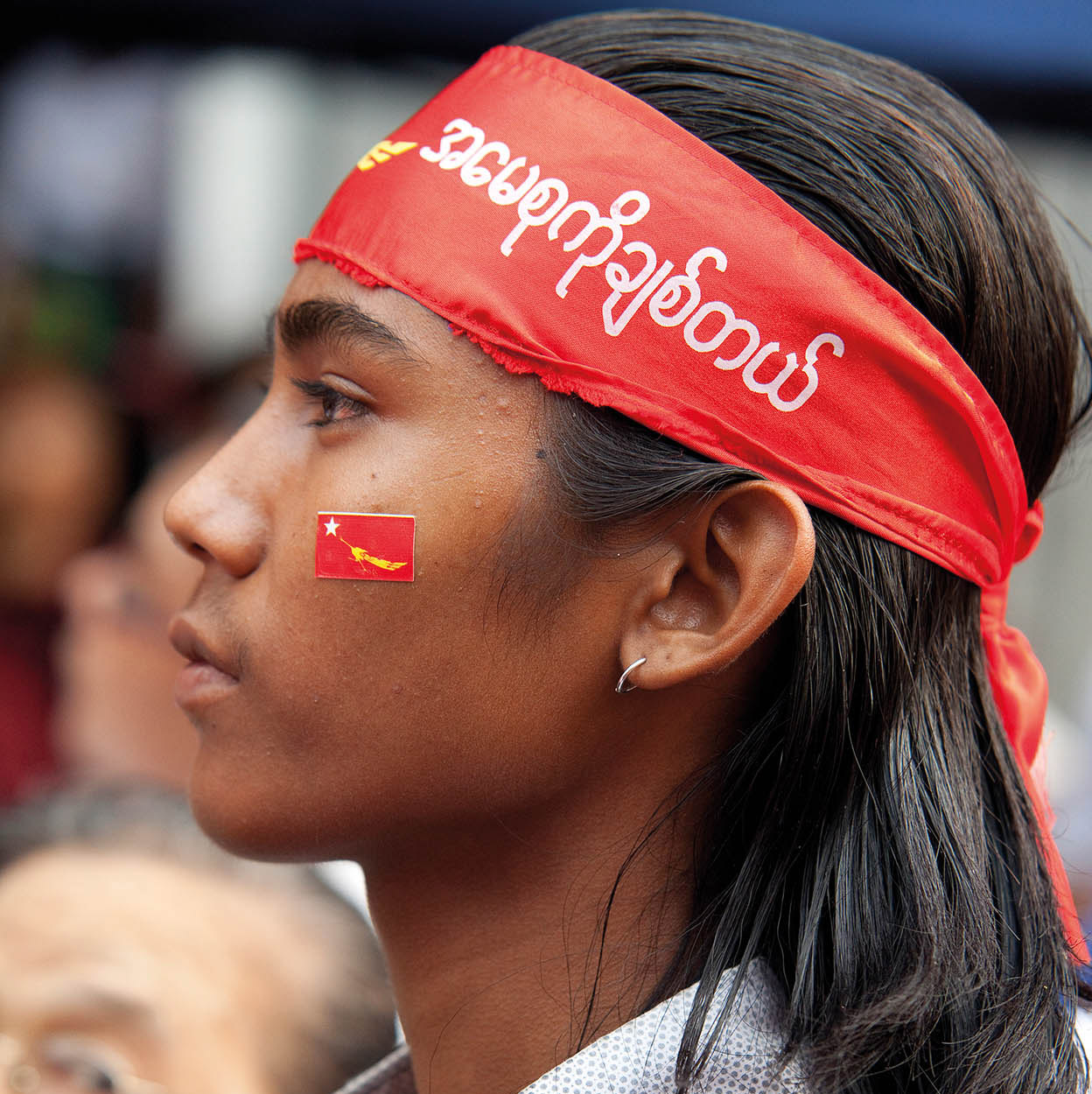
A young protestor at a National League for Democracy demonstration.
Corrie Wingate/Apa Publications
Nominally won by the military-backed Union Solidarity and Development Party, the elections were condemned by the NLD as fraudulent. Yet the reform process gathered momentum nonetheless, with a relaxation of press censorship and the release of hundreds of political prisoners. Visits to Naypyidaw by Hillary Clinton and UK Prime Minister David Cameron underlined support for the reforms by the international community as by-elections in 2012 finally handed Aung San Suu Kyi and 43 other NLD candidates seats in the Burmese parliament.
Whether or not Myanmar is really on the cusp of true democracy, however, remains to be seen – many fear that recent reforms are little more than window-dressing by a government wishing to present a less despotic face to the world. A clause in the 2008 constitution, specifically aimed at Aung San Suu Kyi, bans those with foreign next-of-kin from standing for president, meaning that the ultimate office remains out of reach for the Lady, for the time being at least.
Meanwhile, large sections of the the country’s wealth are still in the hands of the military and their business friends, while the national economy ranks among the least developed in Asia, with a per capita GDP of just $1700 (putting it at number 201 out of 228 countries worldwide). A third of all Burmese still live below the poverty line, and a fifth of all Burmese in rural areas have no reliable source of drinking water, while spending on healthcare and education remains among the lowest in the world. Serious human rights abuses continue to be reported, while major restrictions on the freedom of speech remain. In addition, increasing levels of freedom have been accompanied by rising communal tensions, with Buddhist mobs rioting against Muslims in Meiktila, Mandalay and, especially, Rakhine, where the unfortunate Rohingya (for more information, click here) continue to be threatened with total annihilation.
Future prospects are uncertain, therefore. Possibly the true direction the country is headed in will be seen during and after the next general elections, scheduled for 2015. Only then will we know whether the generals are really willing to usher in genuine democracy, and what form it will take in this ethnically diverse and often fractured country.
Aung San Suu Kyi
Known by her supporters as “The Lady”, Aung San Suu Kyi has come to be seen both in Myanmar and abroad as a symbol of implacable but peaceful resistance to military oppression.
Born in 1945, Aung San Suu Kyi is the daughter of the late Burmese nationalist leader, General Aung San, whose resistance to British colonial rule culminated in independence in 1948. After attending school in Yangon, Suu Kyi lived in India before going to Britain for her higher education. There she met and married her late husband, Michael Aris, an Oxford University professor specialising in Tibetan Studies. Aris accepted that his wife’s destiny might ultimately lie in Myanmar. “Before we were married I promised my wife that I would never stand between her and her country,” he said.
Suu Kyi first came to prominence when she returned home in August 1988 to visit her ailing mother. She became the leader of a burgeoning pro-democracy movement in the aftermath of the brutal repression of the uprising. Inspired by the non-violent campaign of Mahatma Gandhi, Suu Kyi organised rallies and travelled the country, calling for peaceful democratic reforms and free elections. The movement quickly grew into a political party, the National League for Democracy (NLD), which went on to win 51 percent of the national vote and 81 percent of seats in parliament, by which time she had already been under house arrest for a year. The military regime, however, refused to relinquish power and stepped up intensified repression of the NLD.
House arrest and release
Aung San Suu Kyi spent 15 of the next 21 years under house arrest, restricted in her movements and slandered by the pro-government media as a political opportunist and even a “genocidal prostitute”. This last unlikely phrase derived from the military regime’s obsession with her marriage to Michael Aris, who died of prostate cancer in Oxford in 1999 at the age of 53. Throughout Aris’s final illness, the Yangon authorities denied him permission to visit Myanmar. Fearing that she would not be allowed to re-enter the country, however, Suu Kyi declined the option of leaving and remained separated from her husband and two sons at the time of his death.
Finally, decades of international pressure and sanctions bore fruit on 13 November 2010, when the woman regarded by most of the world as Myanmar’s leader-in-waiting was released “for good conduct” from her Yangon home. The end of her detention came only six days after a widely criticised national election.
For most of the following year, the NLD leader campaigned for her party in the run-up to a key by-election in which her party won 43 of the 45 seats it was allowed to contest. In its wake, Aung San Suu Kyi took her seat in the Pyithu Hluttaw, the lower house of Myanmar’s parliament. Her ongoing reintegration into the political life of Myanmar hasn’t been without a certain controversy, however. In 2013 she was widely criticized for failing to speak up for the oppressed Rohingya, while her support for the controversial Leptadaung copper mine also raised eyebrows, as has her apparent willingness to accept party funds from the generals and their business cronies. Exactly what rule the military allow her and the NLD to play in the country’s future political life remains to be seen.
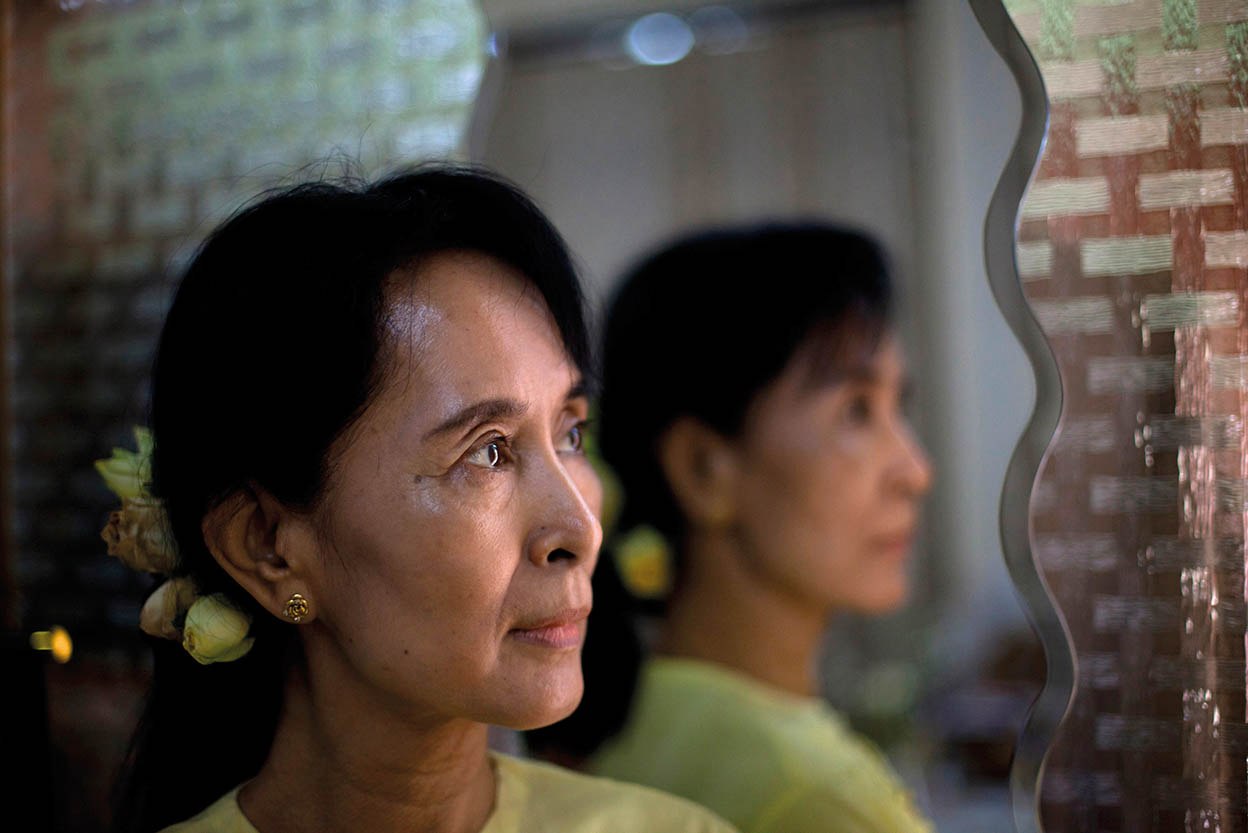
Aung San Suu Kyi
iStock
